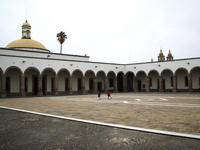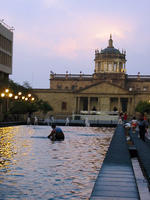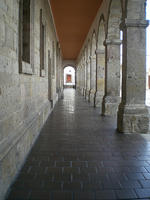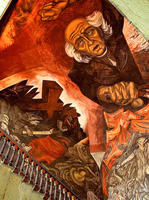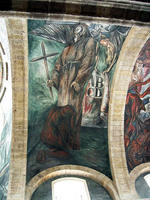You are in: North America -> Mexico -> Hospicio Cabañas, G... , and traditional search or Image Gallery will yield results of this site only
Hospicio Cabañas, Guadalajara
| Site number: | 815 |
|
| Type of site: | Cultural | |
| Date: | 19th century | |
| Date of Inscription: | 1997 | |
| Location: | North America, Mexico, Jalisco, Guadalajara | |
Up to 75 images are shown here. Click on each for more details or on Image Gallery for more images.
| Description: | The Hospicio Cabañas was constructed in the early 19th century to grant protection and shelter for the underprivileged – orphans, old people, the handicapped and chronic invalids. This noteworthy complex was unique for its time, as it encompassed several curious features designed purposely to meet the needs of its occupants. The site is also distinguished for the harmonious relationship it holds between the open and constructed spaces, its minimalist design, and its size. The chapel was decorated with a splendid succession of murals in the early 20th century, which are now deemed among the masterpieces of Mexican art; created by the hand of José Clemente Orozco, one of Mexico’s greatest muralists within that period. --WHMNet paraphrase from the description at WHC Site, where additional information is available. | |
| The Hospicio Cabañas in Guadalajara, Jalisco, Mexico is one of the oldest and largest hospital complexes in Spanish America and a World Heritage Site. The complex was founded in 1791 by the Bishop of Guadalajara in order to combine the functions of a workhouse, hospital, orphanage, and almshouse. It owes its name to Juan Ruiz de Cabañas who was appointed to the see of Guadalajara in 1796 and engaged Manuel Tolsá, a renowned architect from Mexico City, to design the structure. Tolsá's design was based on such classic examples as Les Invalides in Paris and El Escorial near Madrid. The buildings form a rectangle measuring 164 m by 145 m. These are single-storey structures which have 7.5 m in height. The chapel is twice as high and has a dome rising to the height of 32.5 m. The complex is erected on one level, "so as to facilitate the movement of the sick, the aged, and children." Following the death of Cabañas in 1823, construction lasted until 1829. Although it served for a time as a barracks in the mid-19th century, the hospital lasted well into the 20th century and continued to function until 1980, when the Cabañas Cultural Institute, with affiliated schools for arts and crafts, moved in. The highlight of interior decoration is a series of monumental frescoes by José Clemente Orozco, including one of his finest creations, the allegory of The Man of Fire (1936-39). --Wikipedia. Text is available under the Creative Commons Attribution-ShareAlike License. | ||
| Source: | http://whc.unesco.org/en/list/815 | |
| Source2: | http://whc.unesco.org/en/list/815/video | |
| Reference: | 1. UNESCO World Heritage Center, Site Page. | |





